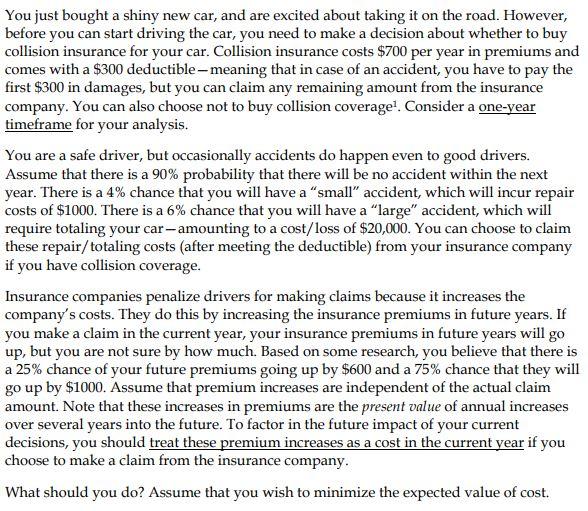

You just bought a shiny new car, and are excited about taking it on the road. However, before you can start driving the car, you need to make a decision about whether to buy collision insurance for your car. Collision insurance costs $700 per year in premiums and comes with a $300 deductible - meaning that in case of an accident, you have to pay the first $300 in damages, but you can claim any remaining amount from the insurance company. You can also choose not to buy collision coverage! Consider a one-year timeframe for your analysis. You are a safe driver, but occasionally accidents do happen even to good drivers. Assume that there is a 90% probability that there will be no accident within the next year. There is a 4% chance that you will have a small accident, which will incur repair costs of $1000. There is a 6% chance that you will have a "large accident, which will require totaling your car - amounting to a cost/loss of $20,000. You can choose to claim these repair/totaling costs (after meeting the deductible) from your insurance company if you have collision coverage. Insurance companies penalize drivers for making claims because it increases the company's costs. They do this by increasing the insurance premiums in future years. If you make a claim in the current year, your insurance premiums in future years will go up, but you are not sure by how much. Based on some research, you believe that there is a 25% chance of your future premiums going up by $600 and a 75% chance that they will go up by $1000. Assume that premium increases are independent of the actual claim amount. Note that these increases in premiums are the present value of annual increases over several years into the future. To factor in the future impact of your current decisions, you should treat these premium increases as a cost in the current year if you choose to make a claim from the insurance company. What should you do? Assume that you wish to minimize the expected value of cost. What should you do? Assume that you wish to minimize the expected value of cost. Use a decision tree to compute the optimal strategy. You just bought a shiny new car, and are excited about taking it on the road. However, before you can start driving the car, you need to make a decision about whether to buy collision insurance for your car. Collision insurance costs $700 per year in premiums and comes with a $300 deductible - meaning that in case of an accident, you have to pay the first $300 in damages, but you can claim any remaining amount from the insurance company. You can also choose not to buy collision coverage! Consider a one-year timeframe for your analysis. You are a safe driver, but occasionally accidents do happen even to good drivers. Assume that there is a 90% probability that there will be no accident within the next year. There is a 4% chance that you will have a small accident, which will incur repair costs of $1000. There is a 6% chance that you will have a "large accident, which will require totaling your car - amounting to a cost/loss of $20,000. You can choose to claim these repair/totaling costs (after meeting the deductible) from your insurance company if you have collision coverage. Insurance companies penalize drivers for making claims because it increases the company's costs. They do this by increasing the insurance premiums in future years. If you make a claim in the current year, your insurance premiums in future years will go up, but you are not sure by how much. Based on some research, you believe that there is a 25% chance of your future premiums going up by $600 and a 75% chance that they will go up by $1000. Assume that premium increases are independent of the actual claim amount. Note that these increases in premiums are the present value of annual increases over several years into the future. To factor in the future impact of your current decisions, you should treat these premium increases as a cost in the current year if you choose to make a claim from the insurance company. What should you do? Assume that you wish to minimize the expected value of cost. What should you do? Assume that you wish to minimize the expected value of cost. Use a decision tree to compute the optimal strategy








